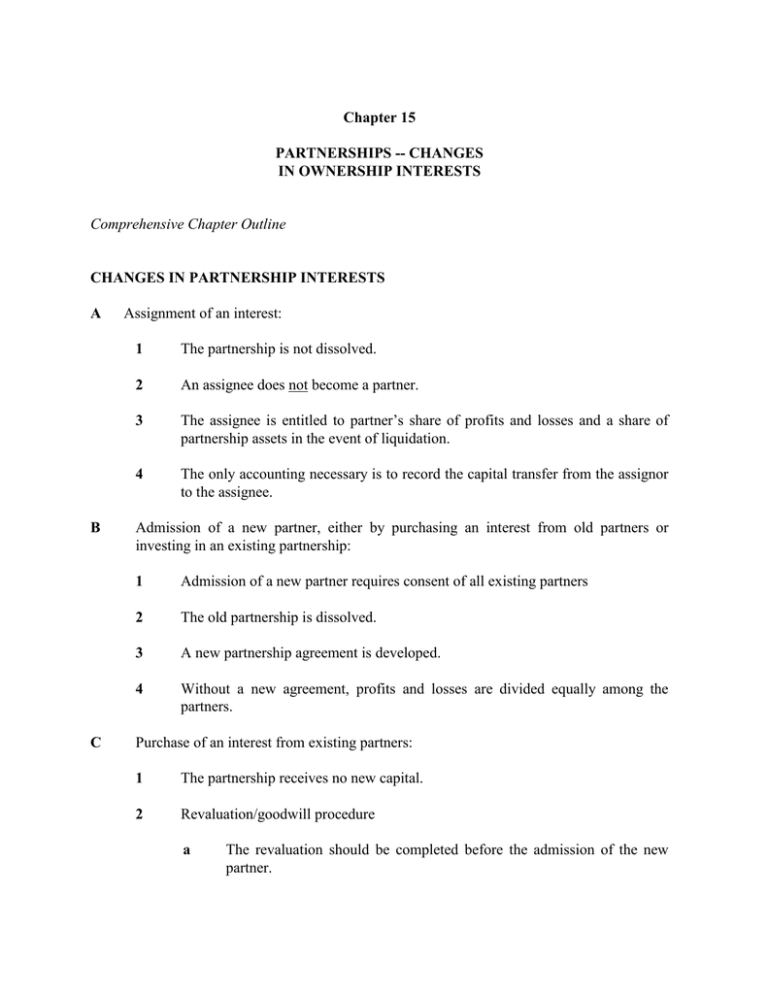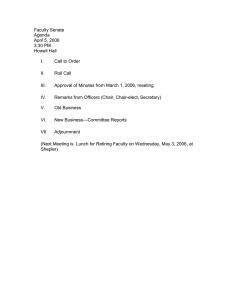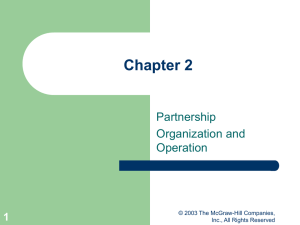The partnership is not dissolved.
advertisement

Chapter 15 PARTNERSHIPS -- CHANGES IN OWNERSHIP INTERESTS Comprehensive Chapter Outline CHANGES IN PARTNERSHIP INTERESTS A B C Assignment of an interest: 1 The partnership is not dissolved. 2 An assignee does not become a partner. 3 The assignee is entitled to partner’s share of profits and losses and a share of partnership assets in the event of liquidation. 4 The only accounting necessary is to record the capital transfer from the assignor to the assignee. Admission of a new partner, either by purchasing an interest from old partners or investing in an existing partnership: 1 Admission of a new partner requires consent of all existing partners 2 The old partnership is dissolved. 3 A new partnership agreement is developed. 4 Without a new agreement, profits and losses are divided equally among the partners. Purchase of an interest from existing partners: 1 The partnership receives no new capital. 2 Revaluation/goodwill procedure a The revaluation should be completed before the admission of the new partner. 3 b Since the partnership receives no money, the amount paid to the old partners provides little evidence for revaluation and appraisals must be relied on for an equitable distribution of total partners’ capital. c Identifiable assets and liabilities are revalued before goodwill is recorded. d Goodwill is amortized over a maximum of 40 years. e An entry is made to transfer capital from the selling partner(s) to the new partner. Nonrevaluation/bonus procedure a The bonus procedure requires entry to transfer capital of old partners to new partner’s capital account. b Without revaluation, new partner’s capital account may not equal his or her payments to the old partners. INVESTING IN AN EXISTING PARTNERSHIP A The old partnership is legally dissolved. B Noncash investments are valued using the same valuation techniques as used for initial investments. C Investment of the new partner is recorded under the provisions of the new partnership agreement. D Basis for revaluation of the partnership: 1 If the new partner’s capital interest in the total of the old capital plus new investment is less than the new partner’s investment, there is an implication that the old partnership had unrecorded asset value. (Illustration 15-2) a Revaluation is determined by dividing the new partner’s capital investment by his or her interest in the new partnership. b The unrecorded asset value may be recognized by the goodwill or bonus approach. (1) Goodwill approach: (2) 2 (a) The difference between the implied value and the total of the old capital plus the new investment is goodwill. (b) The goodwill is divided among the old partners in their old profit and loss sharing ratios before the admittance of the new partners. Bonus approach: The assets are not revalued, but the difference between the new partner’s investment and his/her capital credit is divided among the old partners in their old profit sharing ratios. If the new partner’s capital interest in the total of the old capital plus new investment is greater than the new partner’s investment, there is an implication that the new partner is bringing unidentifiable assets into the partnership. (Illustration 15-3) a The total capital of the new partnership is determined by dividing the old partners’ capital by the old partners’ interest retained in the new partnership. b The unidentifiable asset value from the incoming partner can be recognized by either the goodwill or the bonus approach. (1) Goodwill approach: Assets are revalued to their fair values and goodwill to the new partner is recorded. (2) Bonus approach: (a) Assets are not revalued (b) Capital balances of the old partners are reduced for the bonus to the new partner and the new partner’s capital account is recorded according to the partnership agreement. DISSOLUTION OF A CONTINUING PARTNERSHIP THROUGH DEATH OR RETIREMENT A The old partnership is dissolved and the retiring partner (or estate of a deceased partner) receives a settlement. B If the partnership agreement does not specify a settlement, Section 42 of the Uniform Partnership Act requires the following: 1 2 C The deceased or retiring partner’s interest is valued at the date of dissolution. The retiring partner, or estate of the deceased partner, receives that amount plus interest as an ordinary creditor. a If there is a time lapse between the dissolution and settlement dates, the capital balance is reclassified as a liability. b Any interest on the liability up to the settlement date is an expense of the partnership. Recording the settlement with a retiring or deceased partner: 1 If the retiring partner receives an amount equal to his or her final capital balance, the only entry is a debit to the capital account and a credit to cash. 2 If the retiring partner receives more than the balance in his or her capital account, an undervaluation of the partnership on the partnership books is implied. The excess payment can be recorded in one of three ways 3 a Bonus to the retiring partner: The excess payment to the retiring partner is charged to the remaining partners in their relative profit sharing ratios. b Goodwill equal to the excess payment to the retiring partner is recorded: Goodwill is recorded to the extent paid for by the continuing partnership, in other words, only the retiring partner’s share of partnership assets is revalued. c Revaluation of total partnership capital based on the excess payment to the retiring partner: (1) A total undervaluation of the partnership is determined by dividing the excess payment to the retiring partner by the retiring partner’s profit-sharing ratio. (2) The goodwill is recorded and credited to all partners’ capital accounts before settlement with the retiring partner. If the retiring partner receives less than the balance of his or her account, the partners may agree that the partnership is worth less than its book value. a Overvalued assets should be written down to fair values in the partners’ profit-sharing ratios before settlement with the retiring partner. b Bonus to continuing partners: A bonus equal to the excess of the retiring partner’s capital account over the cash paid by the partnership in settlement of the retiring partner’s interest is credited to the continuing partners’ capital account balances in their relative profit-sharing ratios. LIMITED PARTNERSHIPS A The unlimited liability characteristic is circumvented in this instance. 1 The limited partnership consisits of at least one general partner, who has unlimited liability, and one or more limited partners whose risk whose risk is limited to their equity interest in the venture. 2 The limited partner is excluded from the management of the entity. B The partnership agreement must be written, signed by the partners, and filed with the appropriate state agency.

